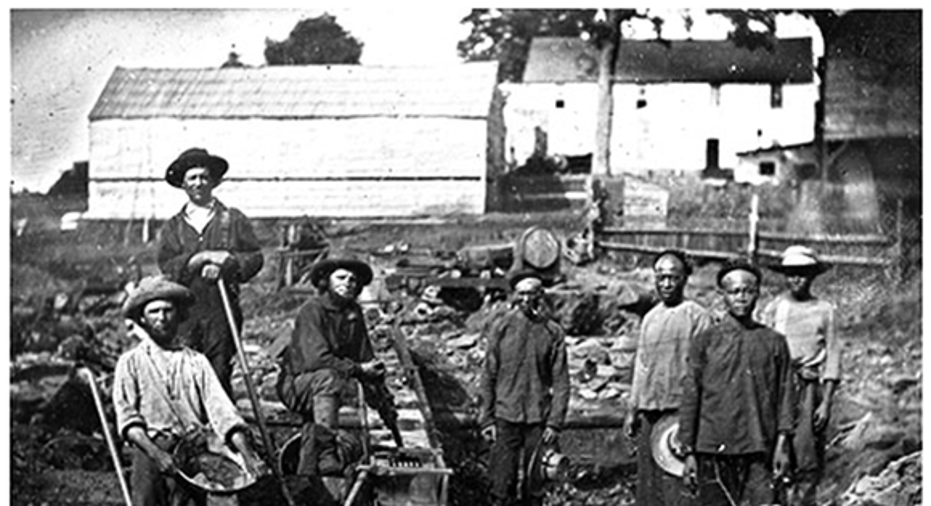How Wells Fargo Survived the Panic of 1855

Miners posefor a photo during the California Gold Rush at Auburn Ravine in 1852. Image source: National Park Service.
The fact that Wells Fargo is one of the safest and most conservative banks in America today wouldn't shock the gold miners in Northern California who served as its first customers during the Gold Rush that began in 1849. Despite being the smallest of its competitors at the time, Wells Fargo was the only one to survive the Panic of 1855.
In hindsight, it's amazing that Wells Fargo was able to get off the ground at all. As Edward Hungerford recounts in his 1949 history of the company, it consisted originally of an express service that transported gold from San Francisco to New York City. It used stagecoaches that then connected with steamships operated by the likes of Cornelius Vanderbilt that provided regular service from one side of the country to the other, by way of Panama or Nicaragua.
By the time Wells Fargo opened for business, the Adams Express Company had already blanketed the state with its express services, while Page, Bacon & Company was the region's leading bank. A gold manifest from a Nov. 1854 steamship offers insight into Wells Fargo's relative position:
|
Company |
Value of Gold Shipment |
|---|---|
|
Page, Bacon & Company |
$417,000 |
|
Adams Express Company |
$350,000 |
|
Wells, Fargo & Company |
$177,000 |
Edward Hungerford, Wells Fargo: Advancing the American Frontier (1949).
All of this changed when a drought in 1854 made it impossible to placer mine for gold. "Trade is utterly prostrate and the pecuniary embarrassments of the mercantile classes have never been equaled since the settlement of the country by the Anglo-Americans," noted the Daily Placer Times and Transcript at the time. "The principal cause producing this state of things has frequently before been alluded to by us -- the absence of sufficient rain to enable the miners to prosecute their labors."
Real estate prices in San Francisco plunged, not unlike the experience in Texas after oil prices decimated the energy industry in the 1980s. The inability to mine also made it impossible for miners to pay back their debts.
Things came to a head in Feb. 1855, after news arrived via steamship that Page, Bacon & Company's parent company in St. Louis had failed after speculating in shares of the Ohio and Mississippi Railroad. This caused a run not only on the venerable bank itself, but also on Adams Express Company. As Alvin Harlow described in his book Old Waybills:
Wells Fargo averted failure not only by proactively paying out depositors, which communicated its strength, but also because it was managed at the time by particularly reputable businessmen. "Most of the money on general deposit was placed here by my friends who believe I am an honest man," wrote the clerk of the Wells Fargo branch in Auburn, California.
Thus, while the panic led to the failure of nearly 200 businesses in San Francisco, the city's two biggest financial concerns among them, it cleared the way for Wells Fargo to gain the position of prominence that it continues to hold today.
Different versions of this story have played out time and again over the past century and a half, and each time it ends the same way. The financial crisis of 2008-09 was the latest example. While many of Wells Fargo's competitors strayed into the world of complex derivatives and esoteric securities backed by subprime mortgages, the 164-year-old California bank stuck to the nuts and bolts of conservative banking. It's a tried-and-true recipe that explains why, even in tumultuous times such as today, Wells Fargo shines as a gleaning beacon for prudent and profitable banking.
The article How Wells Fargo Survived the Panic of 1855 originally appeared on Fool.com.
John Maxfield has no position in any stocks mentioned. The Motley Fool owns shares of and recommends Wells Fargo. The Motley Fool has the following options: short March 2016 $52 puts on Wells Fargo. Try any of our Foolish newsletter services free for 30 days. We Fools may not all hold the same opinions, but we all believe that considering a diverse range of insights makes us better investors. The Motley Fool has a disclosure policy.
Copyright 1995 - 2016 The Motley Fool, LLC. All rights reserved. The Motley Fool has a disclosure policy.



















